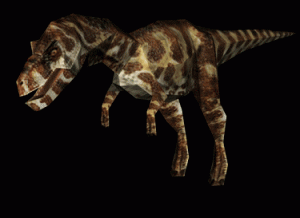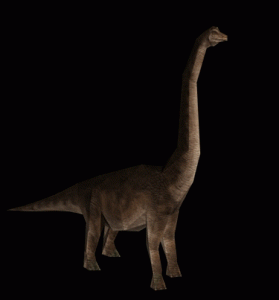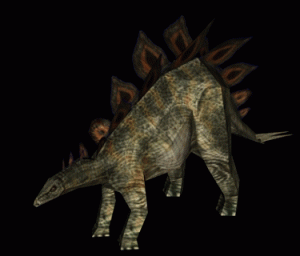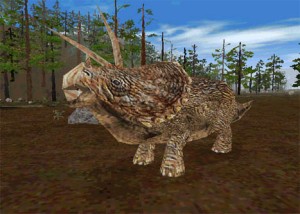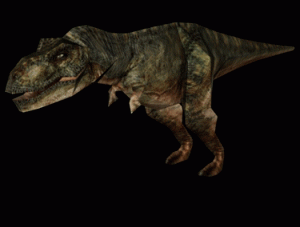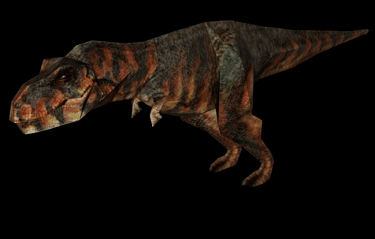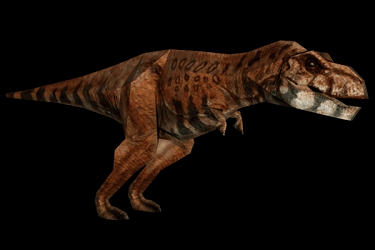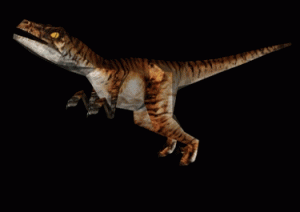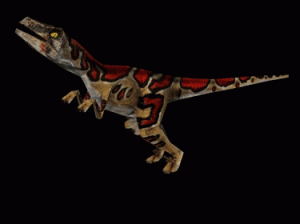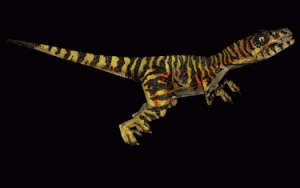Trespasser is a first person action adventure based on The Lost World: Jurassic Park. When it came out in September 1998 it got mostly bad reviews, however there are many people out there who think it’s an excellent game. The game takes place on Site B. Your player is Anne, who crashed on Site B in a passanger plane. Trespasser is a very diverse game, allowing the player to explore jungle, forest, a town, a harbor, a mountian top and more. Your goal is to escape from the island. There are 9 types of dinosaurs, including 3 tribes of Raptors and, of course, the dreaded T-Rex, that make this almost impossible. You’ll find more information about each Dinosaur in the Dinosaurs section. You can also find about 20 different types of guns and other weapons, all of which look and sound like the real thing. Site B is very lush, with tons of trees and plants. It’s landscape also has rocks, ponds, and lots of other stuff. Altogether, Site B represents the most detailed outdoor environment ever created in a game!
Trespasser’s story
The character you play in Trespasser involves a woman named Anne who seems to be going on a vacation to an island in the Pacific Ocean, but whose plane crashes on the way. And we all know where it crashes, on Site B of course. Anne doesn’t realize that until she sees a huge sign that says “Welcome to Site B.” Oops. Anne has read the memoires of John Hammond and therefore kows what it is all about, eventhough she always doubted the existance of Site B. After that you wander all over the place trying to find a radio so you can call for help. All through in the game Anne comments on things she sees, with comments ranging from the strange: “They sure were serious about their monorail”, to the vapid: “No radio, no telephone, no satellite. I’m dead.” Also John Hammond talks in the background about the rise and fall of inGen. We would tell more, but we don’t want to give anything away to those of you who have not yet had the honor of experiencing Trespasser.
Dinosaurs
At this place we present never before seen pictures and detailed info on the Trespasser Dinosaurs. Sit back and study the strengths and weaknesses of your worst enemies! Please note that the info is taken from The Official Trespasser Strategy Guide of Brady Games.
Albertosaurus
Type: Theropoda
Walk: Bipedal
Lived: 76-68 mya
Dimensions: 30 feet long/11 feet tall
Weight: 6,000 lbs.
Variety: Carnivore
Analysis:
The Albertosaurus is faster than the larger Tyrannosaurus Rex and is even more doggedly determined. Like the Raptors, once he gets a whiff of you, he will pursue you through the ends of the earth. Think of him as the perfect cross between theTyrannosaurus Rex and the Raptor. Altough it is sightly easier to kill than theTyrannosaurus Rex, your best strategy with the Albertosaurus is strict and wide avoidance. You can challenge these Dinosaurs if you want, but when they catch up to you and those jaws snap shut, the remaining parts of you will be sorry. They are most vulnerable to automatic weapons. The only reliable way to bring them down is with about 4 Tranquilizer darts, followed by a head full of lead.
Additional info:
The adult Albertosaur is on top of its food chain, and is, therefore, thought of as more of ascavenger than an active hunter. Fast, and highly aggressive, the Albertosaurus tends to hunt alone and is not found in packs.
Brachiosaurus
Type: Sauropoda
Walk: Quadruped
Lived: 113 mya
Dimensions: 82 feet long/45+ feet tall (body: 18 feet tall)
Weight: Over 100,000 lbs.
Variety: Herbivore
Analysis:
The Brachiosaurus is so large, it might as well be a land mass as far as you’re concerned. It won’t notice you and, unless you get under its feet, you won’t notice it. It will take some time to spook these massive beasts, but you should avoid doing so, just in case. TheBrachiosaurus is basically indestructible, so don’t bother
Additional info:
Tending to ignore most event around it, the Brachiosaurus attacks only when provoked.Brachiosaurus is the largest, logest, and haviest dinosaur ever. Recent discoveries, however, show that the Suprasaurus may have grown to nearly 100 feet in lenght. TheBrachiosaurus still reigns, however, because a complete Suprasaurus skeleton at this scale has not been documented.
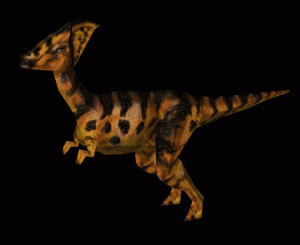
Parasaurolophus
Type: Ornithopoda
Walk: Bipedal
Lived: 76-65 mya
Dimensions: 30 feet long/16 feet tall
Weight: 4,000 lbs.
Variety: Herbivore
Analysis:
Analysis:
Although it is possible to be trampled by a panicked Parasaurolophus, your greatest danger is being too close to these born prey when the predators arrive. Generally, if you see one of these beasts roaming, a predator is just around the corner; when it topples theParasaurolophus, you might be next. Give the Parasaurolophus a wide berth and use it as a distraction for pursuing predators. Given the choice between you and theParasaurolophus, most discerning killers will go for the larger, unarmed prey. They are most vulnerable to automatic weapons. You should avoid shooting them as they are harmless and it would be a waste of ammunition.
Additional info:
The elaborate crest on the skull produces a low frequency sound that can travel over long distances, giving it the ability to communicate with other Parasaurolophuses. A similar system is used by modern whales and elephants. Parasaurolophus is one of the few dinosaurs that have no natural defences, and it tends to be a docile species and is not threatening unless panicked.
Stegosaurus
Type: Stegosauria
Walk: Quadruped
Lived: 150 mya
Dimensions: 29 feet long/8-10 feet tall
Weight: 2,000 lbs.
Variety: Herbivore
Analysis:
For your own safety, stay away from the Stegosaurus. Usually, it poses you no threat, but its miniscule brain can flip quickly, compelling it to consider you as a threat – and then out comes the spiked tail. The only thing that should draw you to a Stegosaurus is your owncuriosity. Its OK to indulge that, but don’t take too many risks. Stegosaurus is so well defended that most predators don’t go after it. Therefore, it is a poor distraction for predators. They are most vulnerable to automatic weapons, still attacking them is useless as they usually cause no threat to you.
Additional info:
A rather slow creature, the Stegosaurus’s placid demeanor can turn violate when it believes itself threatened. They are believed to have perhaps one of the smallest brains of any dinosaur. Still, they can regulate their body temperature by pumping blood in and out of their large plates on the back, a mechanism that is very useful and rare.
Triceratops
Type: Ceratopsia
Walk: Quadroped
Lived: 65 mya
Dimensions: 30 feet long/7-10 feet tall
Weight: 10,000+ lbs.
Variety: Herbivore
Analysis:
The Triceratops is dangerous to be around when it’s frightened. Generally, it pays you no mind, but you should be cautious about a beat that can defeat two attacking Raptors. Keep your distance, but feel free to use them as bait for lurking predators. Unlike the other ‘helpless‘ herbivores, the Triceratops actually has a chance of eliminating the predator for you. They are most vurnerable to automatic weapons, but usually there is no reason for wasting your limited ammo on them.
Additional info:
A hollow high in the skull serves as a shock absorber, cushioning the brain from the impact of hits to the head. More often than not, when the Triceratops lowers its head and branishes its massive frill, its a sign the animal is preparing to attack. The Triceratops head takes up more than one third of its body length. The frill is formed by the enlargements of two of the skull bones, rimmed with bony bumps.
Tyrannosaurus Rex
Type: Theropoda
Walk: Bipedal
Lived: 68-65 mya
Dimensions: 40 feet long/14-20 feet tall
Weight: 14,000+ lbs.
Variety: Carnivore
Analysis:
What can you say? Run, then run some more. You don’t stand much of a chance in a one-on-one fight with a Tyrannosaurus Rex. As the sportscaster cliche’ goes, you can’t stop it, you can only hope to contain it. The Tyrannosaurus Rex is fast, but only in small bursts, if you get a good head start on it, you can outrun it. Slow down, however, and it’ll be right on top of you. When you hear the telltale howl, find cover. If it can’t see you, it won’t come after you. The good news is that the Tyrannosaurus Rex is easily distracted by larger prey and gives up easily. When it catches up, however, it’s all over. Bringing down a T-Rex will take you a while, and a truckload full of bullets. Don’t bother unless you have some heavy things to confront it with. Tanquilizing it won’t help very much as it recovers very fast.
Additional info:
Tyrannosaurus Rex, capable of quick, short bursts of speed, uses its jaws and razor sharp teeth to rip apart its prey in a matter of seconds. Documented as a scavenger, it can feed on animals that are already dead or can take its food from other predators. It’s skull isbred to kill. Almost 4 feet long, its 3-foot-long jaws are lined with 60 dagger-like teeth, some up to 6 inches long and 1 inch wide. Tyrannosaurus Rex’s massive jaw, combined with its lethal teeth, can rip off as much as 500 pounds of meat in one attack. The compression of the jaw can saw through meat and puncture bone with ease.
Other Color Variations
Velociraptor
Type: Theropoda
Walk: Bipedal
Lived: 85-80 mya
Dimensions: 12 feet long/5-6 feet tall
Weight: 160 lbs.
Variety: Carnivore
Analysis:
Your most frequent enemy in Trespasser, the Raptor is a small but deadly foe. Raptorscan easily outrun you and will snuff you out with a couple of quick strikes. They are most vulnerable and easy to hit when they are charging, and they will often pause to glare at you before attacking. Do not let them get in close, or they will snap at your hand and weapon (often knocking it out of your hand). When in close, the Raptor circles you, staying out of your line of sight and nipping at you with its jaw and gruesome hind claw. Whenever possible, snipe Raptors from a distance. The basic rule is never to underestimate their speed and always stay outside of lunge range. You need to aim precisely and quickly to get a clean shot. Another way to loose Raptors (or at least create some distance between you and them) is to weave through trees and rocks. Running in a straight line is certain death, and running uphill is just plain stupid. The only good Raptor is a dead Raptor. Even a squirrely Raptor will charge given the slightest provocation. Most vulnerable to shotguns,rifles, and high-caliber weapons.
Tribe A
Three tribes of Raptors inhabit Site B, the smallest is the so called ‘Jungle Raptor’ as it inhabits the lower regions of Site B, namely the jungle and plains. Being the weakest of the three kinds you should still be aware as they often sneak up from behind or trick you with other clever moves.
Tribe B
A lot larger than the Tribe A Raptors, these ‘Forest Raptors’ inhabit the cooler and darker regions of Site B, mostly forests, and do not reach the speed of their smaller brothers. Still, they are more dangerous as they are stronger and more aggressive.
Tribe C
Being the smallest but yet most dangerous, strong and aggressive Raptor, the ‘Mountain Raptors’ choose the higher levels of Site B as their home, that is mostly the mountains. They often hunt in packs, so watch out. One never comes alone.
Additional info:
Individually, Velociraptors most likely snapped up large lizards or small mammals, but a pack of Raptors would ususally join forces to attack larger animals.The hind limbs are a work of natural, biological art. The main weapon in the Velociraptor’s attack, the Raptor’s hind limbs are agile and muscular, able to chase and then lunge at its intended prey. Once upon its prey, the Raptor uses its claws to tear into its victim.
Write a comment
You need to login to post comments!







